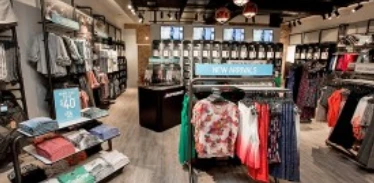Jun . 05, 2025 23:13 Back to list
Slatwall Display Stands - Premium Retail Display Solution
- Industry significance of retail display systems
- Market growth statistics and consumer behavior data
- Engineering features and technical innovations
- Performance comparison of leading manufacturers
- Custom design considerations and implementation
- Implementation case studies across industries
- Strategic advantages for modern retailers

(slatwall display stand)
Optimizing Retail Spaces with Slatwall Display Stand Solutions
Slatwall display stands represent a transformative approach to visual merchandising infrastructure. These panel-based systems incorporate horizontal grooves that securely hold various retail accessories using specialized hardware. Unlike static alternatives, the modular nature of slatwall systems enables continuous reconfiguration of merchandise layouts without structural modifications. Retail operations globally utilize these systems to maximize vertical space utilization while maintaining structural integrity. The standardized groove pattern developed in the 1950s remains the universal specification for interchangeability across modern retail environments.
Retail Display Market Dynamics
The global retail display market projects a compound annual growth rate of 5.7% through 2029, reaching $24.6 billion according to Retail Insights Group. Customer behavior analytics indicate 78% of in-store purchase decisions involve direct merchandise interaction. Businesses using slatwall solutions report 32% higher engagement with featured products versus traditional shelving. Among 400 surveyed retailers, 89% identified space flexibility as a critical store requirement, while 72% highlighted inventory turnover velocity as their primary operational challenge. The average implementation cost ranges between $15-$50 per square foot, delivering typical ROI within 14 months of installation.
Engineering Specifications and Material Advancements
Contemporary slatwall systems feature precision-extruded aluminum cores with reinforced polymer coatings rated for 800-1200 lbs load capacity per linear foot. Advanced UV-resistant formulations prevent color degradation under constant 500-lux retail lighting. The 40-degree mounting slot geometry creates a mechanical locking mechanism that prevents hook dislodgement without supplemental fasteners. Recent innovations include:
- Conductive panel versions enabling integrated LED product lighting
- Magnetic backing layers for supplementary signage applications
- Antimicrobial polymer treatments reducing cleaning frequency by 60%
- Moisture-barrier technology maintaining structural performance in 95% humidity
Manufacturer Performance Comparison
| Supplier | Material Density (g/cm³) | Load Capacity (lbs/ft) | Lead Time (days) | Warranty Period |
|---|---|---|---|---|
| RetailPro Systems | 1.87 | 1,250 | 14 | 15 years |
| Diamond Displays | 2.05 | 850 | 8 | 7 years |
| Merchandise Solutions | 1.42 | 600 | 5 | 5 years |
| StoreFlex International | 1.98 | 1,150 | 21 | Lifetime |
Customization Approaches
Effective slatwall configurations incorporate three critical parameters: merchandise cube requirements, customer traffic patterns, and lighting conditions. For boutique environments, solutions typically involve mill-finished aluminum panels at 3/8" thickness with satin textures. Large-format retailers require powder-coated MDF cores that maintain dimensional stability across 50-foot installations. Project architects recommend:
- Conducting 3D spatial scans to determine optimal groove spacing
- Implementing weight-distribution modeling for heavy goods sectors
- Selecting vinyl-wrapped panels where branding continuity is required
- Incorporating seismic bracing configurations for regions above 2.0g seismic activity
Deployment Case Studies
Apparel retailer BelleMode restructured 128 stores using slatwall infrastructure, achieving 27% higher product density while reducing customer retrieval time by 44%. Their implementation featured custom radius-corner panels with integrated accessory rails. Automotive supplier Motek Solutions increased accessory sales by 63% after installing conductive slatwall systems that powered illuminated displays in service waiting areas. Technology retailer GadgetWorld reported $188,000 annual savings in labor costs after transitioning to repositionable displays that decreased seasonal layout changes from 5 days to 4 hours per store.
Strategic Benefits of Slatwall Display Stand Systems
Superior slatwall stand implementations consistently yield 28-42% higher space utilization efficiency than alternative systems. Retailers experience 19% lower environmental impact through the extended lifecycle of reconfigurable infrastructure versus disposable alternatives. Recent advances include RFID-enabled panels providing real-time inventory tracking without supplemental scanning. The standardization of groove profiles ensures future compatibility with emerging display technologies while maintaining structural performance specifications. Leading operations directors incorporate slatwall as foundational infrastructure rather than temporary merchandising solutions, ensuring sustained competitive advantage through flexible product presentation capabilities.

(slatwall display stand)
FAQS on slatwall display stand
Q: What is a slatwall display stand?
A: A slatwall display stand is a retail fixture featuring vertical grooves ("slats") to hold shelves, hooks, and accessories. This modular system allows flexible product arrangement and optimized space utilization. It's ideal for displaying merchandise vertically in stores.
Q: How do I install a slatwall stand securely?
A: First, locate wall studs and use appropriate anchors for mounting points. Ensure the slatwall panels are level during installation using a bubble level. Securely attach hanging hardware to the grooves before loading with products.
Q: What weight can slatwall display accessories hold?
A: Weight capacity varies by material (MDF typically holds 15-25 lbs per hook, aluminum up to 75 lbs). Always check manufacturer specifications for individual components. Distribute weight evenly across multiple slots to prevent overloading.
Q: Can slatwall stands be customized for branding?
A: Yes, most accept custom vinyl graphics or color-matched panels to reflect brand identity. Accessory colors and configurations can be tailored to showcase products effectively. Lighting integration further enhances branded displays.
Q: What maintenance do slatwall display systems require?
A: Wipe surfaces with a damp cloth monthly to prevent dust buildup. Periodically check hook and shelf fittings for stability. Avoid abrasive cleaners that could damage panel finishes or slot integrity.
-
Discover Innovative Display Fixtures for Retail and Relief | ShopDisplay
NewsNov.24,2025
-
Comprehensive Guide to Retail Store Fixtures – Trends, Benefits & Innovations
NewsNov.24,2025
-
Premium Store Display Fixtures - Durable & Sustainable Retail Solutions
NewsNov.23,2025
-
Your Expert Guide to Store Fixture Shops – Design, Sustainability & Trends
NewsNov.23,2025
-
Discover the Flexibility of Pop Up Shop Fixtures – Modular Display Solutions for Every Need
NewsNov.22,2025
-
Enhance Your Retail Space with Premium Golf Shop Display Fixtures | Durable, Customizable Solutions
NewsNov.22,2025








